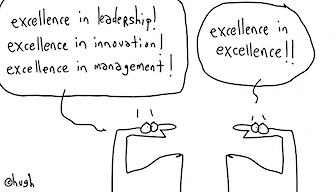Revisiting the “Innovation Buzzword”

This post is a revisiting to something I wrote 13 years ago. I’m not seeing to much change, except perhaps for my writing having slightly improved through age and the reduction of my hyperbole. The diplomacy however has not improved …
Innovation remains just a Buzzword in most organisations.
Wikipedia defines a buzzword as:
“a word that has begun to be used in the wider society outside of its original context by nonspecialists who use the term vaguely or imprecisely. Labelling a term a “buzzword” often pejoratively implies that it is now used pretentiously and inappropriately by individuals with little understanding of its actual meaning who are most interested in impressing others by making their discourse sound more esoteric, obscure, and technical than it otherwise would be.”
“Innovation” remains one of our great go-to Buzzwords.
It seems our senior executives are still talking-up innovation, which is not a bad thing I guess, however it still largely ends at the talking. Innovation effectively remains “Bureaucratised”, i.e. it is sanitised into a form that is focused on controllable outputs with little regard to outcome & impact.
Innovation remains a key component in most speeches. When we speak of innovation however, we speak in glowing terms of the potential it offers, but neglect the balance of the equation which involves implementation and the change it brings. Talking innovation is important of course, but beyond this it involves novel thinking and most importantly, moving to some form of action. As a result, few go further than the talk.
Why do we stop at the talk? Because innovation can be challenging!
Quite apart from the threat of instituting processes that would challenge the status quo (the very antithesis of bureaucratic control), Innovation is like operating in a fog. We cannot say with certainty where we are going until we get there, i.e we cannot see the value until that is delivered.
Chief amongst the obstacles is that truly innovative ideas are rarely understood and can seem threatening initially. It is only with successful implementation that that we can see the value they may offer. So we will only ever appreciate an innovation in hindsight, after we have moved to action!
How then do we garner support for ideas that are generally unsupported in organisations and where it is far too easy to say “No”, without even having to say “no”? Even a skeptical eyebrow raised in the right context can kill a possible breakthrough innovation, right on the spot. This is the challenge!
Understanding safe ways and means of moving to ACTION then, is a key to success.
We’ve all heard our bureaucrats spruik innovation and tell us that we need to think differently and we need be challenged, however when the challenges come, little changes in the modus operandi of dealing with them. We default to the linear and structured approaches of the past. This is not a critique as such given some of these approaches have worked well and that we are in fact, wired to default to the known and understood. However as complexity increases around us and the pace of change accelerates, the new and creative approaches that are essential, are mostly shunned. When this occurs, innovation remains just a buzzword.
The continued use of the “innovation word” in many cases amounts to little more than a form of ‘bureaucratic chicanery’ in which words, glossy brochures, posters, strategies and talking about action, substitute for action itself.
The Federal Government’s not so recent 2020 Summit (held in 2008) proved a perfect example of the bureaucratisation of innovation. I just don’t know that many of the thousands of ideas generated there have been appropriately harvested, improved upon or moved to impactful action, but wow, was the event talked up! (NB: the passage below about the 2020 Summit was drawn from wikipedia during the drafting of this piece).
There was no continuing secretariat for any follow-up action for the recommendations from the conference or the ten subgroups or forums. The Treasurer managed to get a review of the taxation system, to be prepared by the Treasury, but in May 2010 when the Prime Minister eventually released the report, he rejected 135 of the 138 recommendations. “The 2020 summit provided a paradigm for much of the activity in the Govt’s term of office … Rhetoric inspired and enthused voters. And yet … and yet … nothing happened.
When you can look under desks in most organisations and see rolls of butcher paper that are gathering dust, open up any one of these and you’ll find a multitude of post-it-notes with ideas that staff were asked to present. These ideas were never honoured nor actioned. When you find such rolls of butcher paper lying around, you know that innovation is just a buzzword.
If we can put innovation into enough speeches, documents, ppt presentations, business plans and strategic plans (always a popular one)! we must then be doing innovation. Right?
In environments where everything is first viewed through a lens of risk, it is extremely difficult to gain the permission required to undertake the thinking & experimenting required for innovation to happen. In large organisations too, those more likely to challenge the status quo and attempt to do things differently, are the ones most likely to be sidelined and disempowered. Where this happens, innovation remains just a buzzword.
My favourite quote from Edward deBono is: “You cannot dig a hole in a different place by digging the same hole deeper”.
Many of our managers are furious diggers in that original hole. What can you do to help them to climb out and try digging a in different place?

Comments
No comment yet.